You really only need to modify the plotting command from the answer that @PoGibas linked: here
library(png)
library(ggplot2)
genderselection <- read.table(text="
Gender Freq
F 70
M 30
", header=T)
pcts <- round(prop.table(genderselection$Freq)*100)
# Load png file from imgur as binary
con <- url("https://i.imgur.com/vFDSFYX.png",
open='rb')
rawpng <- readBin(con, what='raw', n=50000)
close(con)
img <- readPNG(rawpng)
h <- dim(img)[1]
w <- dim(img)[2]
# Find the rows where feet starts and head ends
pos1 <- which(apply(img[,,1], 1, function(y) any(y==1)))
mn1 <- min(pos1)
mx1 <- max(pos1)
pospctM <- round((mx1-mn1)*pcts[2]/100+mn1)
pospctF <- round((mx1-mn1)*pcts[1]/100+mn1)
# Fill bodies with a different color according to percentages
# Note that this relies on the fact that the png is a bitmap.
# The png is expressed as a matrix with a cell for each pixel
# and 3 layers for r,g,b.
dim(img)
#> [1] 360 360 3
# Create a 2d matrix by just taking the red values
# Image is black and white so black corresponds to 0
# white corresponds to 1. Then change the values of
# the cells to correspond to one of three categories.
imgmtx <- img[h:1,,1]
whitemtx <- (imgmtx==1)
colmtx <- matrix(rep(FALSE,h*w),nrow=h)
midpt <- round(w/2)-10
colmtx[mx1:pospctM,1:midpt] <- TRUE
colmtx[mx1:pospctF,(midpt+1):w] <- TRUE
imgmtx[whitemtx & colmtx] <- 0.5
# Need to melt the matrix into a data.frame that ggplot can understand
df <- reshape2::melt(imgmtx)
head(df)
#> Var1 Var2 value
#> 1 1 1 0
#> 2 2 1 0
#> 3 3 1 0
#> 4 4 1 0
#> 5 5 1 0
#> 6 6 1 0
cols <- c(rgb(255,255,255,maxColorValue = 255),
rgb(209,230,244,maxColorValue = 255),
rgb(42,128,183,maxColorValue = 255))
# Then use a heatmap with 3 colours for background, and percentage fills
# Converting the fill value to a factor causes a discrete scale.
# geom_tile takes three columns: x, y, fill corresponding to
# x-coord, y-coord, and colour of the cell.
ggplot(df, aes(x = Var2, y = Var1, fill = factor(value)))+
geom_tile() +
scale_fill_manual(values = cols) +
theme(legend.position = "none")


